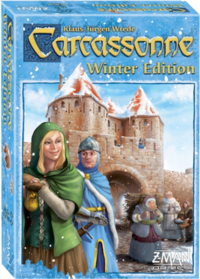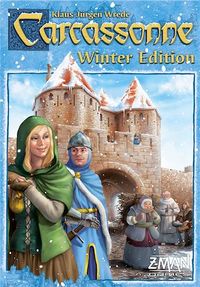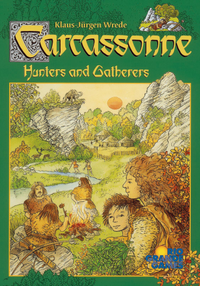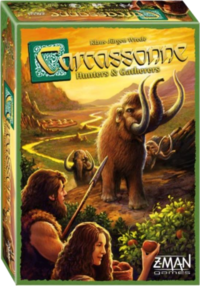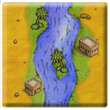User:Black Bear/Introductions/Spin-offs
| Article | Before | After | ||||
|---|---|---|---|---|---|---|
| Winter Edition |
A clever tile-laying game, in a winter coat, for 2 to 5 players, aged 8 and above, by Klaus-Jürgen Wrede. The city of Carcassonne in southern France is famous for its unique Roman and Medieval fortifications. The players take their chances with their followers in the cities, cloisters, roads, and snowy fields around Carcassonne. The development of the land is in their hands, and the skillful deployment of the followers as thieves, knights, monks, and farmers is the path to success. |
| ||||
| Winter Edition Base Game |
Carcassonne: Winter Edition was originally released by Hans im Glück in 2012. A clever tile-laying game, in a winter coat, for 2 to 5 players, aged 8 and above, by Klaus-Jürgen Wrede. The city of Carcassonne in southern France is famous for its unique Roman and Medieval fortifications. The players take their chances with their followers in the cities, cloisters, farms and on the roads around Carcassonne. The development of the land is in their hands, and the skillful deployment of the followers as thieves, knights, monks and farmers is the path to success. |
| ||||
| Winter Edition The Gingerbread Man |
The Gingerbread Man was originally released by Hans im Glück in 2012 and is an expansion for the Winter Base Game. There exists two versions of the punchout. Interestingly, the misprint (tile in the upper richt corner is identic to the tile in the upper left corner) is much wider than the correct print. Winter has broken out in Carcassonne. It's cold, but romantic, it is a time of hot drinks and sweet pastries. Life in the cities of Carcassonne is just a bit slower. But occasionally a new fellow pops up - have you already found him? |
| ||||
| Winter Edition Die Kornkreise |
The Winter Corn Circles was originally released by Hans im Glück in 2015 and is an expansion for the Winter Base Game. Strange Corn Circles appear in the middle of the Carcassonne countryside. Or more precisely, melted snow in strange forms, which influence the life of the followers in Carcassonne. |
| ||||
| Gold Rush |
Originally released by Hans im Glück in 2014, Carcassonne: Gold Rush is an exciting tile-laying game set during the gold rush of the Wild West for 2 to 5 players, ages 8 and up. Gold Rush is based on Carcassonne, and part of the "Carcassonne Around The World" series of standalone games, but is not compatible with Carcassonne or any of the other Carcassonne spin-off games. The game uses many of the standard Carcassonne game concepts, but moves it from mediaeval France to the American Wild West. "An unknown frontier stretches out before us. Construction of the first railroad lines has begun and the tireless work of the settlers is finally paying off as they leave their tents behind to prosper in the thriving cities that you helped to build. Trading with the natives is a lucrative affair and wild horses are especially valuable. But watch out, there’s gold in them hills! Everyone’s looking to get rich quick, so get to the mountains before the others mine them dry." WICA NotesTwo versions of the rules were published in German during 2014, as were the rules produced in English by Z-Man Games. The second German version contained a number of corrections to the first (the main one being a correction to the Tile Distribution). Initially, the following are based on the Z-Man Games version of the rules. Additional comments and clarifications have come from various Carcassonne discussion forums (BGG, CarcC and CarcF). |
| ||||
| Gold Rush Base Game |
Originally released by Hans im Glück in 2014, Carcassonne: Gold Rush is an exciting tile-laying game set during the gold rush of the Wild West for 2 to 5 players, ages 8 and up. The Wild West – A land full of untamed wilderness. The construction of the first railway lines into the area brings the settlers out of their tents and into thriving mining cities. Trade with the native Indians is lucrative; especially valuable are the wild horses. But when veins of gold are discovered in the mountains, there is no stopping the mad rush for it - everyone wants to get rich overnight. But beware! Many of the gold mines may already have been picked clean by your competition, and before you know it, the gold nuggets are all gone. When you play the game, everyone has gold fever! |
| ||||
| Gold Rush The Sheriff |
Originally released by Hans im Glück in 2014 at Essen Spiel, The Sheriff is a mini-expansion for Carcassonne: Gold Rush. |
The Sheriff (Der Sheriff in german) is a minor expansion for Carcassonne: Gold Rush, originally released by Hans im Glück in 2014 at Essen Spiel. | ||||
| Gold Rush Fan Expansions |
There are several fan-maintained websites that contain fan expansions for Carcassonne and its variants and spin-offs games, including Gold Rush. The two most active are CarcassonneCentral (English speaking) and CarcassonneForum (German). There are smaller (national) sites which may also contain locally developed expansions - for example, there is a Czech site, and there has previously been one in the Netherlands, while BoardGameGeek may also contain fan expansion ideas. |
| ||||
| Gold Rush Tile Reference |
The distribution list here is organised by the topology of the edges. For example :-
The tile notation and headings are ordered alphabetically, according to the following hierarchy :-
Practically speaking, that means that a mountain is always placed at the top, and the rest of the tile described clockwise from that starting point. If there is more than one mountain, the first mountain - again seen clockwise - is placed at the top. If there is no mountain at all, then a prairie is placed at the top, and so on. For example:- |
| ||||
| Hunters and Gatherers |
Originally released by Hans im Glück in 2002. Thousands of years before the present city of Carcassonne was built, the area was already populated. The people hunted wild animals, gathered berries and caught fish for their daily survival. Even today there remains fantastic cave paintings and archaeological finds from which we understand the lives of those days. |
| ||||
| Hunters and Gatherers Base Game |
Originally released by Hans im Glück in 2002. Thousands of years before the present city of Carcassonne was built, the area was already populated. The people hunted wild animals, gathered berries and caught fish for their daily survival. Even today there remains fantastic cave paintings and archaeological finds from which we understand the lives of those days. |
| ||||
| Hunters and Gatherers Scout |
The Scout is originally released by Hans im Glück in 2003 (as part of King and Scout, which also featured 7 tiles for Carcassonne). |
| ||||
| The Ark of the Covenant |
Introduction [1]by Jonathan Warren The Ark of the Covenant is a game that was developed by Klaus-Jürgen Wrede, the author of Carcassonne. The game was published, in 2003, by Überplay Entertainment under their Inspiration Games imprint that marketed games especially for the religious market. A German edition, entitled Die Baumeister des Königs, followed in 2004, published by Diehl Medien. The Ark of the Covenant is a stand-alone game based on the Carcassonne series, but is not compatible with Carcassonne or any of the other Carcassonne spin-off games. As of April 2008, Überplay Entertainment has gone out of business. This has made getting hold of The Ark of the Covenant difficult. The Ark of the Covenant is the more mature version of Carcassonne. It was released over two years after the original Carcassonne, and one year after Hunters and Gatherers was released, and as such it was able to benefit from play testing of both, the result being a more elegant gameplay. Some gamers prefer to play a game of The Ark of the Covenant rather than 'vanilla' [2] Carcassonne for this reason. It is an excellent game for those wanting to play a basic version of Carcassonne without all the expansions. Some fans have affectionately renamed it Arkcassonne or Carc of the Ark. There have been two rule sets produced for The Ark of the Covenant (2003, 2005). The second edition sought to clarify some issues raised as a consequence of the first edition rule set. The clarifications of the second edition are provided in the annotations of this document. The differences between The Ark of the Covenant and the German release, Die Baumeister des Königs, are also shown in the annotations. The Question and Answer footnotes refer to official responses to the question posed. As The Ark of the Covenant was released first in English, it is the English version that the following sections follow. WICA NotesIn 2008 The Ark of the Covenant CAR was written from the perspective of the First Edition, with corrections from the later edition included in footnotes. This version has been changed to include the information from the second edition in the main body of the text, with changes from the first edition referenced in the Notes. |
The Ark of the Covenant is a game that was developed by Klaus-Jürgen Wrede, the author of Carcassonne. The game was published, in 2003, by Überplay Entertainment under their Inspiration Games imprint that marketed games especially for the religious market. A German edition, entitled Die Baumeister des Königs, followed in 2004, published by Diehl Medien. The Ark of the Covenant is a stand-alone game based on the Carcassonne series, but is not compatible with Carcassonne or any of the other Carcassonne spin-off games. As of April 2008, Überplay Entertainment has gone out of business. This has made getting hold of The Ark of the Covenant difficult. The Ark of the Covenant is the more mature version of Carcassonne. It was released over two years after the original Carcassonne, and one year after Hunters and Gatherers was released, and as such it was able to benefit from play testing of both, the result being a more elegant gameplay. Some gamers prefer to play a game of The Ark of the Covenant rather than 'vanilla' [3] Carcassonne for this reason. It is an excellent game for those wanting to play a basic version of Carcassonne without all the expansions. Some fans have affectionately renamed it Arkcassonne or Carc of the Ark. There have been two rule sets produced for The Ark of the Covenant (2003, 2005). The second edition sought to clarify some issues raised as a consequence of the first edition rule set. The clarifications of the second edition are provided in the annotations of this document. The differences between The Ark of the Covenant and the German release, Die Baumeister des Königs, are also shown in the annotations. The Question and Answer footnotes refer to official responses to the question posed. As The Ark of the Covenant was released first in English, it is the English version that the following sections follow. WICA NotesIn 2008 The Ark of the Covenant CAR was written from the perspective of the First Edition, with corrections from the later edition included in footnotes. [4] This version has been changed to include the information from the second edition in the main body of the text, with changes from the first edition referenced in the Notes. | ||||
| The Ark of the Covenant Base Game |
The Ark of the Covenant was originally released in 2003 [5] Based on the 2001 Game of the Year: Carcassonne [6] A Clever Tile-Laying Game for 2-5 Players Ages 8 and up, by Klaus-Jürgen Wrede.[7] "Joshua has led the children of Israel into the Promised Land and you have been given the unique responsibility to help develop the area by building roads, cities, temples and raising sheep. Deploy a Prophet into the cities to preach repentance. Take on the sacred duty of moving The Ark of the Covenant around to different areas of the Land." Answer: The game teaches no doctrine – it is based on an Old Testament theme, and has common Old Testament references like prophets and temples, but that’s the extent of the doctrine. It should be non-offensive for anyone, regardless of their religious beliefs. |
| ||||
| Ark Fan Expansions |
There are several fan-maintained websites that contain fan expansions for Carcassonne and its variants and spin-offs games, including The Ark of the Covenant. The two most active are CarcassonneCentral (English speaking) and CarcassonneForum (German). There are smaller (national) sites which may also contain locally developed expansions - for example, there is a Czech site, and there has previously been one in the Netherlands, while BoardGameGeek may also contain fan expansion ideas. As the main game is no longer commercially available, and not widely played, it is likely that there will be few changes to the contents, or status, of the list of expansions in the future. To access these files and discussions you will usually have to register on the site first. |
| ||||
| Ark Tile Reference |
The distribution list here is organised by the topology of the edges. For example:-
The tile notation and headings are ordered alphabetically, according to the following hierarchy:-
Practically speaking, that means that a city is always placed at the top, and the rest of the tile described clockwise from that starting point. If there is more than one city, the first city - again seen clockwise - is placed at the top. If there is no city at all, then a field is placed at the top, and so on. For example:- |
|
- ↑ This introduction and other content have been taken from The Ark of the Covenant Complete Annotated Rules (CAR) v1.2 12/2008 which was released on the Carcassonne Central website. Minor changes have been applied during conversion to this wiki version.
- ↑ 'Vanilla' Carcassonne is a term used by players referring to a game of Carcassonne without any of its various expansions being included.
- ↑ 'Vanilla' Carcassonne is a term used by players referring to a game of Carcassonne without any of its various expansions being included.
- ↑ Introduction and other content have been taken from The Ark of the Covenant Complete Annotated Rules (CAR) v1.2 12/2008 which was released on the Carcassonne Central website by Jonathan Warren. Minor changes have been applied during conversion to this wiki version.
- ↑ The first edition English rules (2003) were developed by Jeremy Young, Matt Molen and Guido Teuber. This development team were joined for the second edition release (2005) by Rick Thornquist and Greg Aleknevicus.
- ↑ Carcassonne by Klaus-Jürgen Wrede is published by Hans im Glück (European edition) and Rio Grande Games (American English edition) Ed: RGG was the English publisher in 2008, when the CAR was produced. Since that time the English version of Carcassonne has also been published by Z-Man Games.
- ↑
 The first edition read: 'A Clever Tile-Laying Game for 2-5 Players aged 10 and above'
The first edition read: 'A Clever Tile-Laying Game for 2-5 Players aged 10 and above'
